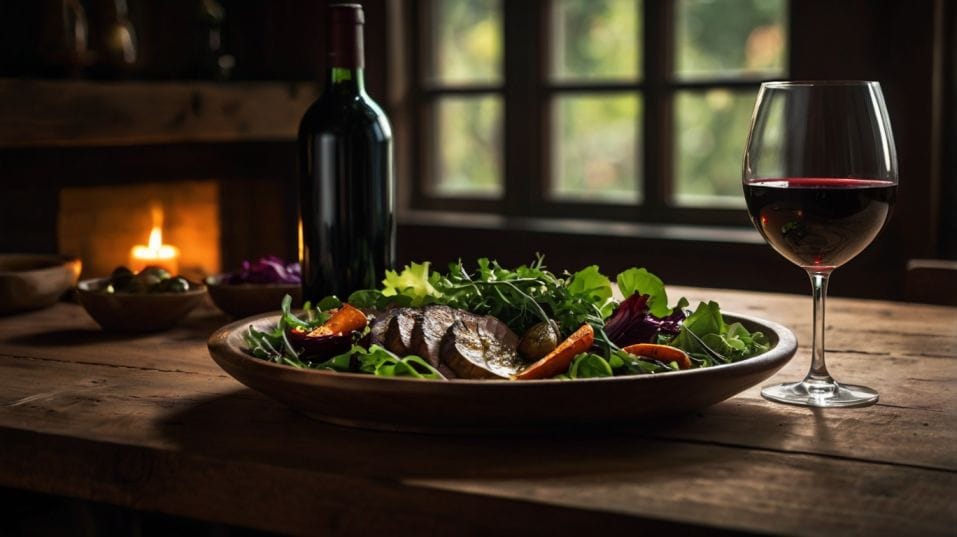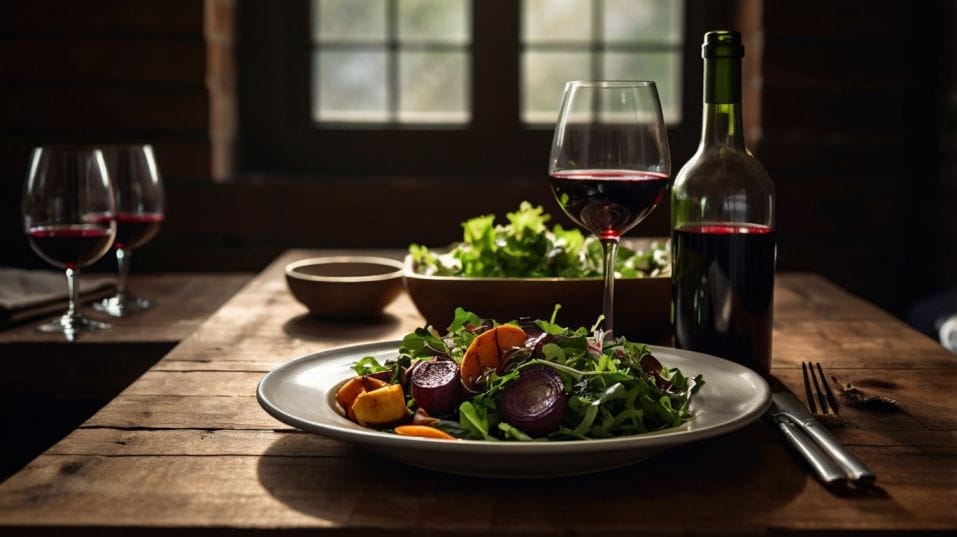You Can Pair Red Wine with Salad (Sometimes)
Yes, red wine can go with salad. Learn how to pair them like a pro by focusing on acidity, texture, and temperature.

Think red wine and salad can’t mix? Think again. While old-school rules warn against it, the right red can elevate even the greenest plate.
It’s not about breaking tradition—it’s about tuning into balance. With a few smart tweaks to your wine and salad game, you’ll unlock bold, delicious pairings that defy expectations and reward curiosity. Ready to rethink what’s in your glass?
The Real Reason It’s “Hard”
Most of the tension between red wine and salad comes down to structure—specifically tannin and acid.
Red wines bring tannins, which are the compounds that create a drying, slightly bitter sensation in your mouth (think of over-steeped black tea). Greens like arugula, spinach, and kale can also have bitter or peppery tones.
Combine them carelessly, and the whole pairing leans harsh and astringent. Add a sharp vinaigrette, and the acidity can exaggerate the wine’s alcohol or strip away its fruit.
It’s not that red wine can’t go with salad—it’s that certain reds, and certain salads, don’t flatter each other. And without understanding why, it’s easy to assume the whole category is off-limits.
But just as there are dozens of red wine styles, there are just as many kinds of salads—warm, savory, sweet, grilled, grain-based, cheese-laden. It’s not about salad as a category. It’s about the composition of flavor and texture.

Focus on the Style of Red
Not all reds are built for power. Some are made for freshness, agility, and finesse. That’s where you start.
Look for reds with:
- Bright acidity – This is non-negotiable. Acidity in wine keeps things lifted, especially when your food already has a tart element like vinegar, tomato, or citrus. Think Pinot Noir, Gamay, Frappato, Barbera, Zweigelt, or cool-climate Cabernet Franc.
- Low to medium tannins – Big, dense reds can bulldoze a salad. Stick with varieties that offer texture without too much grip. Even some Tempranillos or light Syrahs, if made in a restrained style, can work.
- Moderate alcohol – Alcohol accentuates bitterness and spice. Reds in the 11.5% to 13.5% ABV range will feel more agile and flexible in your pairing.
And don’t be afraid to chill it. A slight chill (15–20 minutes in the fridge) can make a red wine feel fresher, more vibrant, and more in sync with cool or room-temperature dishes.
Let the Salad Lead
Forget about “salad” as a monolith. You’re not pairing with greens—you’re pairing with the dominant flavors and textures of the dish.
Salads with Earthy or Roasted Ingredients
Beets, mushrooms, squash, lentils, roasted carrots—these ingredients add depth and umami that can support a red.
Try a Pinot Noir with beet and goat cheese, or a Barbera with a lentil and roasted pepper salad. These combinations bridge the gap between lightness and savoriness.
Salads with Protein
Grilled chicken, steak slices, seared tuna, cured meats—these aren’t “light” flavors. They need wines with structure, just not too much.
A chilled Nebbiolo with rare steak and arugula, or a Grenache-based blend with grilled chicken and smoked paprika, can be exceptional.
Salads with Cheese or Nuts
Parmesan, blue cheese, feta, aged goat—these bring fat and salt, which soften tannin and amplify fruit. Walnuts, pecans, or almonds can do the same.
Suddenly, a medium-bodied red like a Loire Cabernet Franc or a Tuscan Sangiovese feels right at home.
Grain or Legume-Based Salads
Think farro, couscous, chickpeas, white beans. These are hearty, savory, and slightly nutty—perfect for reds with structure but not weight. Try a Cinsault or a light Carignan with a farro salad and grilled eggplant.
Don’t Overlook the Dressing
This is where most pairings fall apart. Acidic dressings like lemon or vinegar-forward vinaigrettes can flatten red wine or make it taste metallic. But with a few tweaks, you can build dressings that harmonize.
A red-wine-friendly dressing might include:
- A softer acid: balsamic, sherry vinegar, or pomegranate molasses
- A balancing agent: honey, Dijon, fruit puree, or even roasted garlic
- A fat to round it out: olive oil, avocado oil, or tahini
Think of it this way—if your dressing is bright, sharp, and edgy, it’s asking for a zippy white. But if it’s got some depth and roundness, it invites red wine to the table.
Bonus: Add a Warm Element
Temperature contrast matters more than most people realize. A salad that includes a warm component—roasted vegetables, grilled meats, even just toasted seeds—can change how a red wine interacts with the dish.
Warmth brings out the aroma of the wine, softens tannin perception, and makes the whole experience feel more integrated.
So if your red wine pairing feels like it’s almost working, try warming one element of your salad. That small shift might be all it takes.
Final Thoughts
You don’t need to throw out everything you’ve heard about red wine and salad—but you do need to look closer.
Acid, tannin, texture, and temperature all play a role. When you understand them, you gain more than a new pairing—you gain control over your experience.
Next time you're planning a meal, don’t sideline red wine just because salad’s involved. Reach for a leaner, brighter bottle.
Reimagine your vinaigrette. Add an earthy topping, a salty edge, or a touch of warmth. Then pour, taste, and pay attention.
Let your curiosity guide you—not convention. Try the match, trust your palate, and build the kind of wine ritual that rewards confidence and creativity every time.




